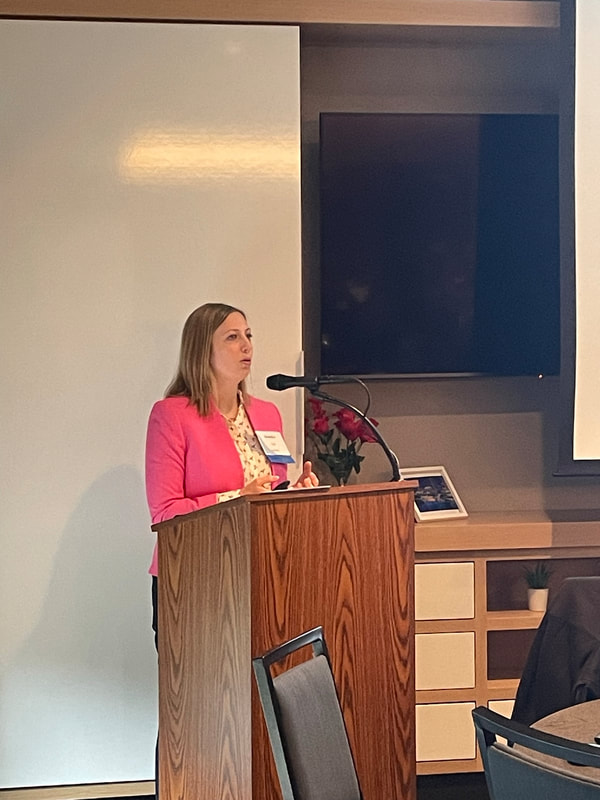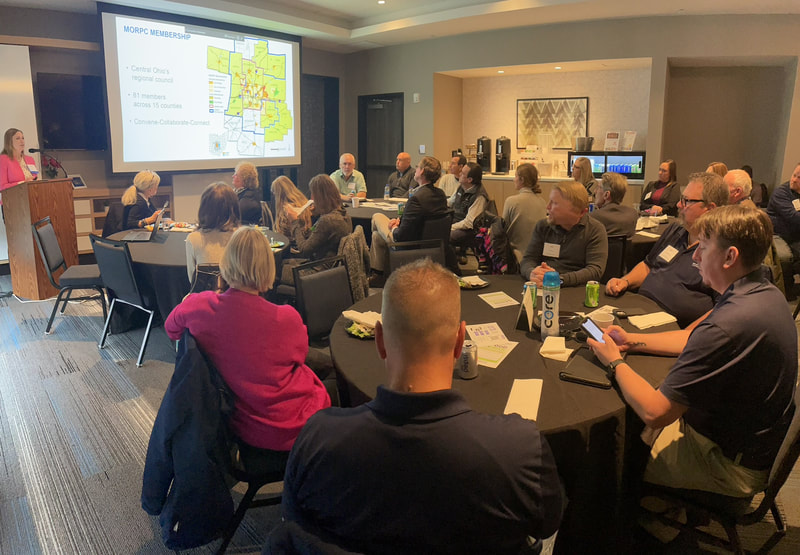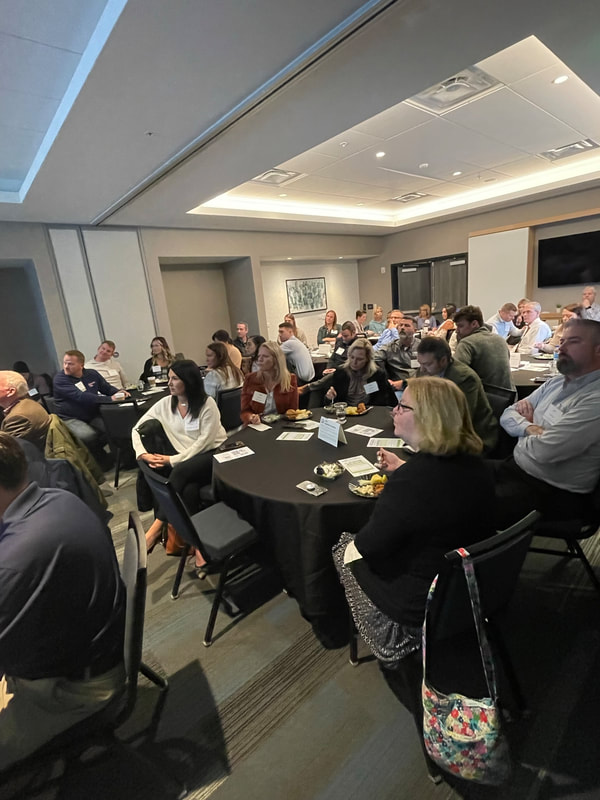November General Meeting
'We Need More Housing' Dominant Theme of November General Meeting
For the final time in 2022, CAA Members gathered at the new Hyatt House hotel near the campus of The Ohio State University for the last General Meeting of the year featuring Jennifer Noll of the Mid-Ohio Regional Planning Commission (MORPC) detailing the need for housing in Central Ohio.
CAA Executive Director Laura Swanson welcomed members and made a few short announcements before asking CAA President, Steve Papineau to the podium. Papineau had the honor of recognizing this year’s recipients of the CAA Community Assistance Foundation grants. Papineau invited representatives from Hope Hollow, Patches of Light and Move to PROSPER to come forward and receive their contributions. Representatives from COMPASS were unable to attend.
Following the Community Assistance Foundation presentations Papineau welcomed Noll, the Associate Director for Community Development with MORPC as the Keynote speaker.
Noll began with a bit of background information abut MORPC and what they do, likening them to a Chamber of Commerce, but instead of serving local businesses they serve local governments focusing on the future of the region, collaboration on shared goals and priorities and connecting members to resources whether it’s advocacy or just connecting to local and national peers.
“It’s our responsibility and our duty to bring back as much resource as we can to Central Ohio, so we can deliver that into our communities and maintain a high quality of life across the region,” Noll said.
Starting the conversation by stating that the idea that Central Ohio is a growing region is not a new one, but that the region has been growing steadily for decades. Rather, it’s on track to become a region of three million people by 2050. There are roughly 2.4 million residents today. This projection remains accurate, however, MORPC is in the process of evaluating the impacts of the major employer announcements on the short-term and long-term projections.
“We’re starting to think that it’s not going to look very different by 2050, the projection remains steady because the model was pretty sophisticated,” Noll said. “We didn’t necessarily know that Intel was coming, but we knew that Central Ohio has a lot of the qualities in place that attract employers from across the country and around the world. We can anticipate those things as we evaluate what our communities will look like in 20 or 30 years.”
One thing that may change is how and where the area grows. MORPC has projected where growth will occur noting that growth tends to occur where growth has already occurred. This is particularly relevant when talking about the potential of Intel.
Noll showcased a map with drive times based on the Intel location and how far from the development individuals would have to drive to work there during peak rush hour getting as far out as a 60-minute commute. Noll pointed out that the circle with the furthest distance from Intel touched 20 counties.
“What that tells us is that we can be prepared to see a lot of growth happening. This is going to be a huge investment, not only for Central Ohio, but we’re talking about a statewide impact from Intel and the businesses that are going to be supporting it,” Noll continued. “Growth is not going to be evenly distributed. There’s a law of physics that says over the course of humanity, people have been inclined to travel about 30 minutes to wherever it is they’re going. If we’re thinking about where folks are going to live who are going to be working at Intel, they’re most likely to be within a 30-minute drive time.”
Central Ohio is very fortunate to attract employers like Intel and have Honda and Ohio State expand its footprint. It is a good problem to have. However, it is not without its concerns that communities are not going to be able to meet businesses and resident needs. Currently in Central Ohio too many households are paying too much for their housing. As a result, it’s leaving less money available for other, equally important expenses.
The primary concern for the business community remains the ability to attract and retain their workforce. The main reason for this is the lack of near-by, affordable housing for workers. MORPC is encouraging communities to think about new housing every time they think about new jobs. Asking them to consider where the workforce is going to live.
“Housing has been an issue for our communities for several years, about five years ago members were encouraging MORPC to convene conversations and help understand what the core issues are within Central Ohio when it comes to supply and affordability,” Noll said. “In 2020 the Regional Housing Strategy was released for Central Ohio to figure out what the solutions are to housing and affordability.”
The strategy was guided by a vision where growth and post-pandemic recovery would help to realize more equity among Central Ohioans. Housing, where built and maintained, who its for and how it is priced can be a solution to this vision. Through research, it was found that there are five core issues to the housing crisis. The issues are not unique to Central Ohio. Supply and demand, barriers to securing housing, limited supply of homes priced for lower income households, growing demand for diverse housing stock and finally, housing instability.
With so much need for housing the question remains, why isn’t there more product? Noll outlined the four biggest challenges to the development community. They are local land use and approvals processes, increased cost of construction materials and labor, not in my backyard (NIMBY) attitudes, lastly, there’s a need for gap financing.
MORPC is encouraging communities to think about housing stock as an investment portfolio. If the portfolio is spread with a diverse housing stock at all price points, the risk is spread out and more opportunity is created.
“We need to be thinking wholistically and comprehensively about the types of housing we have in our communities. Simply put, our communities need more housing, and our residents need more housing options.” Noll said. “From MORPC’s perspective we’re encouraging our communities to think not only in terms of housing options, but mobility and transportation options. We have evaluated this; we can quantify the returns to the community if they consider more housing and transportation options.”
Noting that often this thought process to development requires fewer tax dollars, dollars can be spread out to go further and create cost savings for households. The most important part of the process is not only understanding the issues but turning to the solutions in the communities. MORPC provides a toolkit on their website that can help with those solutions.
Housing continues to be a priority for Central Ohio communities, MORPC is providing a lot of assistance and support into technical assistance programs and other resources with a lot more to come in the year ahead. At the end of the day, communities are encouraged to think about housing as a critical part of wholistic neighborhoods and how that fits in to the communities.
Following Noll’s presentation Swanson returned to the podium and invited new members to stay for an informational meeting and Associate Members to stay for the annual Expo Booth Lottery. Otherwise, Swanson wished everyone a happy holiday season before adjourning.
CAA Executive Director Laura Swanson welcomed members and made a few short announcements before asking CAA President, Steve Papineau to the podium. Papineau had the honor of recognizing this year’s recipients of the CAA Community Assistance Foundation grants. Papineau invited representatives from Hope Hollow, Patches of Light and Move to PROSPER to come forward and receive their contributions. Representatives from COMPASS were unable to attend.
Following the Community Assistance Foundation presentations Papineau welcomed Noll, the Associate Director for Community Development with MORPC as the Keynote speaker.
Noll began with a bit of background information abut MORPC and what they do, likening them to a Chamber of Commerce, but instead of serving local businesses they serve local governments focusing on the future of the region, collaboration on shared goals and priorities and connecting members to resources whether it’s advocacy or just connecting to local and national peers.
“It’s our responsibility and our duty to bring back as much resource as we can to Central Ohio, so we can deliver that into our communities and maintain a high quality of life across the region,” Noll said.
Starting the conversation by stating that the idea that Central Ohio is a growing region is not a new one, but that the region has been growing steadily for decades. Rather, it’s on track to become a region of three million people by 2050. There are roughly 2.4 million residents today. This projection remains accurate, however, MORPC is in the process of evaluating the impacts of the major employer announcements on the short-term and long-term projections.
“We’re starting to think that it’s not going to look very different by 2050, the projection remains steady because the model was pretty sophisticated,” Noll said. “We didn’t necessarily know that Intel was coming, but we knew that Central Ohio has a lot of the qualities in place that attract employers from across the country and around the world. We can anticipate those things as we evaluate what our communities will look like in 20 or 30 years.”
One thing that may change is how and where the area grows. MORPC has projected where growth will occur noting that growth tends to occur where growth has already occurred. This is particularly relevant when talking about the potential of Intel.
Noll showcased a map with drive times based on the Intel location and how far from the development individuals would have to drive to work there during peak rush hour getting as far out as a 60-minute commute. Noll pointed out that the circle with the furthest distance from Intel touched 20 counties.
“What that tells us is that we can be prepared to see a lot of growth happening. This is going to be a huge investment, not only for Central Ohio, but we’re talking about a statewide impact from Intel and the businesses that are going to be supporting it,” Noll continued. “Growth is not going to be evenly distributed. There’s a law of physics that says over the course of humanity, people have been inclined to travel about 30 minutes to wherever it is they’re going. If we’re thinking about where folks are going to live who are going to be working at Intel, they’re most likely to be within a 30-minute drive time.”
Central Ohio is very fortunate to attract employers like Intel and have Honda and Ohio State expand its footprint. It is a good problem to have. However, it is not without its concerns that communities are not going to be able to meet businesses and resident needs. Currently in Central Ohio too many households are paying too much for their housing. As a result, it’s leaving less money available for other, equally important expenses.
The primary concern for the business community remains the ability to attract and retain their workforce. The main reason for this is the lack of near-by, affordable housing for workers. MORPC is encouraging communities to think about new housing every time they think about new jobs. Asking them to consider where the workforce is going to live.
“Housing has been an issue for our communities for several years, about five years ago members were encouraging MORPC to convene conversations and help understand what the core issues are within Central Ohio when it comes to supply and affordability,” Noll said. “In 2020 the Regional Housing Strategy was released for Central Ohio to figure out what the solutions are to housing and affordability.”
The strategy was guided by a vision where growth and post-pandemic recovery would help to realize more equity among Central Ohioans. Housing, where built and maintained, who its for and how it is priced can be a solution to this vision. Through research, it was found that there are five core issues to the housing crisis. The issues are not unique to Central Ohio. Supply and demand, barriers to securing housing, limited supply of homes priced for lower income households, growing demand for diverse housing stock and finally, housing instability.
With so much need for housing the question remains, why isn’t there more product? Noll outlined the four biggest challenges to the development community. They are local land use and approvals processes, increased cost of construction materials and labor, not in my backyard (NIMBY) attitudes, lastly, there’s a need for gap financing.
MORPC is encouraging communities to think about housing stock as an investment portfolio. If the portfolio is spread with a diverse housing stock at all price points, the risk is spread out and more opportunity is created.
“We need to be thinking wholistically and comprehensively about the types of housing we have in our communities. Simply put, our communities need more housing, and our residents need more housing options.” Noll said. “From MORPC’s perspective we’re encouraging our communities to think not only in terms of housing options, but mobility and transportation options. We have evaluated this; we can quantify the returns to the community if they consider more housing and transportation options.”
Noting that often this thought process to development requires fewer tax dollars, dollars can be spread out to go further and create cost savings for households. The most important part of the process is not only understanding the issues but turning to the solutions in the communities. MORPC provides a toolkit on their website that can help with those solutions.
Housing continues to be a priority for Central Ohio communities, MORPC is providing a lot of assistance and support into technical assistance programs and other resources with a lot more to come in the year ahead. At the end of the day, communities are encouraged to think about housing as a critical part of wholistic neighborhoods and how that fits in to the communities.
Following Noll’s presentation Swanson returned to the podium and invited new members to stay for an informational meeting and Associate Members to stay for the annual Expo Booth Lottery. Otherwise, Swanson wished everyone a happy holiday season before adjourning.
| Intel Part 2_MORPC |











